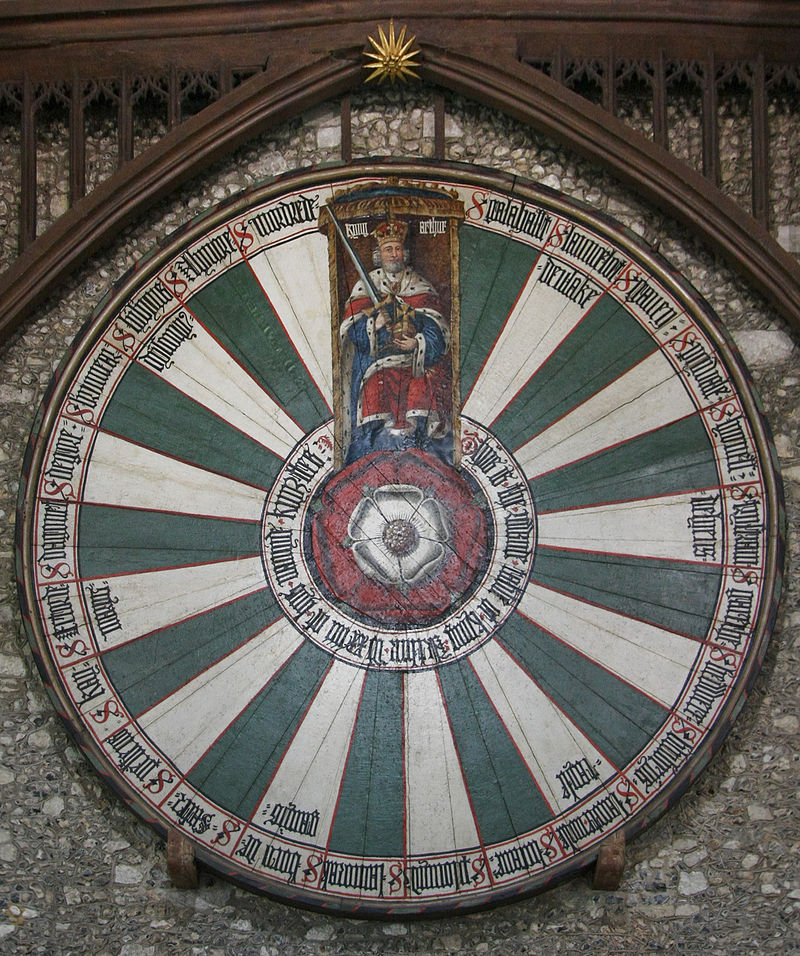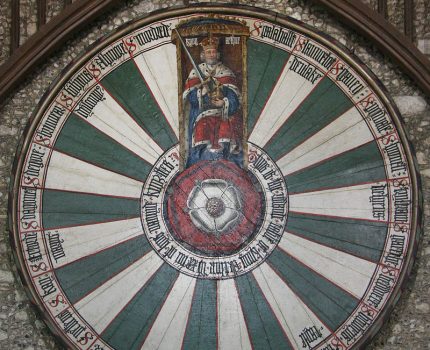
High on the west end wall in the Great Hall of Winchester Castle hangs a huge wooden disk known as King Arthur’s Round Table. But is it the actual Round Table used by that legendary order of chivalrous knights? In 1976, the mysterious 18 foot in diameter Round Table, weighing well over a ton, was taken down for investigation. Below are the top ten facts revealed about this unique and historic artifact.
1) A huge wooden disk known as King Arthur’s Round Table hangs in Winchester Castle
There is a massive wooden disk that measures over 18 feet in diameter hanging currently on the west end wall of the Great Hall at Winchester Castle. It is elaborately painted with King Arthur shown at the head of the table. Along the outer edge of this disk is painted not only King Arthur’s name, but 24 other knights’ names, in alternating green and white spaces. In the center is a circular inscription surrounding a rose that says,
“This is the Round Table of King Arthur and Twenty Four of his Named Knights.”
2) The painted disk was once an actual Table
When taken down in 1976, holes for attaching legs, since removed, confirmed it was once used as an actual table, and not just a decorative piece of art placed on the wall. (It wasn’t painted upon initial creation though- see #7)
3) First written account of a King Arthur’s Round Table is found in 1155
There are multiple meanings to Round Table, and different uses have been noticed when referring to King Arthur’s ‘Round Table’.
The word Round Table could refer to the famed piece of furniture that allows all who sit around it to have equal status. It could be King Arthur’s chivalric order of knights itself. Or it could be an entertaining gathering of knights with tournaments, music, food, and other festivities.
Although Geoffrey of Monmouth, in 1136AD, is first known to have written in his Historia Regum Britanniae about the noble King Arthur who fought brilliantly in defense of Britain in the 5/6th century, he does not make mention of a Round Table. First written account of a Round Table comes later with Wace’s Roman de Brut in 1155. In this work is the following:
“Because of these noble lords about his hall, of whom each held himself to be the best, and none would count himself the least praiseworthy, Arthur made the Round Table, concerning which the Bretons tell many stories. This Round Table was ordained of Arthur that when his fair fellowship sat to meet their chairs should be high alike, their service equal, and none before or after his comrade. Thus no man could boast that he was exalted above his fellow, for all were seated alike, and there was none outside.”
It is clear it is a piece of furniture here. However in Wace’s next use of Round Table, he indicates it is the actual order of knights:
“Of such knights as were of the king’s house and served him about his court, who were his chosen friends, who are of the Round Table, of those I cannot tell more.”
Then, in later uses, and most likely how the Round Table of Winchester Castle came to be was that a Round Table was considered a ‘celebratory event’. Royals were known to hold ‘Round Tables’ and invite lords and ladies from all across the lands to their event. It is believed an event (a Round Table) was held at Winchester Castle, and a physical Round Table was made in honor of the themed King Arthur Round Table.
4) The Round Table once hung on the East Wall of the Great Hall
The first recorded mention of the specific Round Table at Winchester Castle is by John Hardyng in his work Chronicle of 1464. He wrote:
“The Round Table at Winchester began
And there it end and there it hangeth yet”
There isn’t any record of the Table before this. No one knows for absolute certain when it was built or hung on the wall. However, from his statement, it is clear the Table had been there for quite some time. Plus, it is known the table was originally positioned on the East Wall. In 1873, renovations were done to the Great Hall, and the Round Table was then moved to the West Wall, where it hangs today.
5)The Winchester Castle Round Table dates back to around the 1300’s
Upon examination in 1976, the wood of the Round Table of Winchester Castle has been concluded to date between 1250 to 1350. It does not date back far enough to have been the actual table used by King Arthur in the 5/6th century. (That is if there was an actual King Arthur, and this remains in debate).
6) The Round Table was most likely hung in the Great Hall by either King Henry III or King Edward I
The Great Hall of Winchester Castle was completed in 1235. King Henry III was ruler at this time and so could have had the Round Table hung on the East Wall sometime after the hall’s completion and decoration.
However, most suspect the Round Table was commissioned by King Edward I. Arthurian myths were popular during his reign ( 1272 to 1307), and Edward I was known to have been an enthusiast of all Arthurian history and legend. He also held many ‘Round Tables’, and financial accounts seem to suggest the table could have been commissioned for an event held in 1290 at Winchester celebrating the marriage of his daughter.
7)The Round Table is thought to have had a cloth covering and not painted until 1516
X rays show the table wasn’t painted until 1516, and was later repainted in 1789. There wasn’t any paint beneath the layer of 1516. However, further study of the table revealed tiny tack marks around the rim, suggesting, initially, the table was covered by a decorative cloth.
There isn’t any remnants of this cloth left today, and so it is not known what illustration it might have displayed. Surely something, and most likely a theme of King Arthur of which the later painting mimicked.
8) The original list of knights on the Round Table is a mystery
The source for the knights named on the Round Table is a mystery. Of all the literary works studied, it was discovered most of the names can be found in Sir Thomas Malory’s work of 1470 titled Morte Darthur (21 of the 24 names). But, not all can. Some of the knights’ named are missing from his account.
It leaves the question, ‘Is there a missing Arthurian work lost from which the list on the table was referencing?’ It is possible the artist used multiple sources, but it is not known why the following 24 knights were chosen, or if they were originally on the decorative cloth.
The list of King Arthur’s Knights are, going clockwise from King Arthur: galahallt, launcelot, gauen, percyvale, lyonell, trystram, garethe, bedwere, blubrys, lacotemale, lucane, plomyde, lamorak, bors, safer, pelleus, kay, ectorde, dagonet, degore, brumear, lybyus, alynore, and mordrede.
9)The Round Table was damaged by bullets
When the Round Table was inspected in 1976 it was noticed there were holes in the table filled with cork. These holes were fixed before the 1789 repaint. Upon further investigation, and with support the holes were suspiciously dense around the face of King Arthur and the center of the table, an ideal place of target, it was discerned the table was damaged by bullet holes. It is believed the shooting of the table was from Cromwellian soldiers in 1645.
10) The Round Table was rehung in 1980 after its study
After being taken down off the west wall in 1976, the table was studied extensively, and rehung in 1980. All the modern technologies at the time were employed to find clues to its history. It became known the table could not have been made in the time of King Arthur, but only made in honor of this legendary King and his chivalric knights sometime between 1250AD and 1350AD. For some, this was disappointing.
To others though, it gained respect. The Round Table of Winchester Castle was revealed to be a unique piece of history. It hangs in reverence for a time past, but not forgotten. And it still holds it mystery.
.


thank you, i found this very interesting,